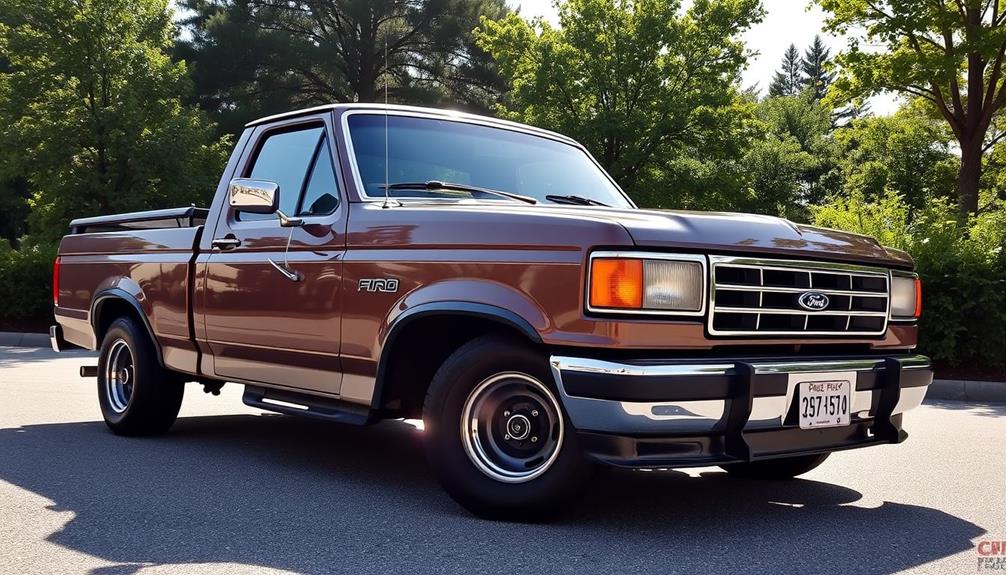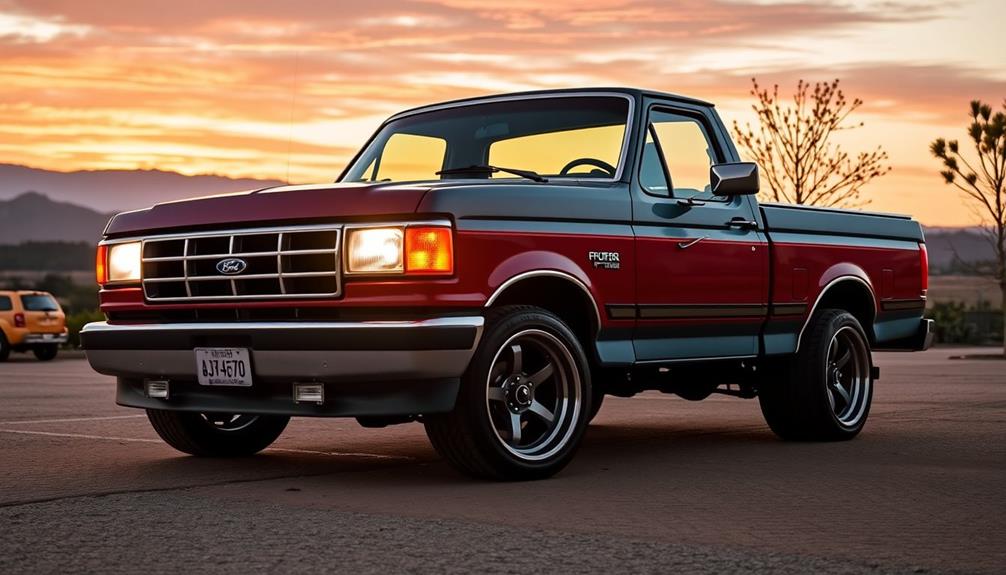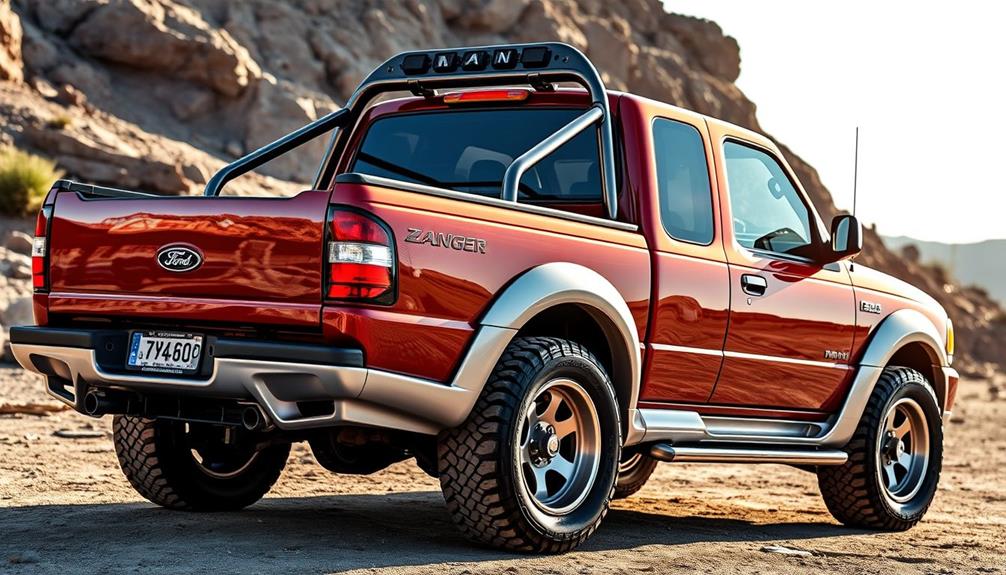To modernize the power of your 1990 Ford F-150, start with engine modifications like installing long tube headers and swapping the camshaft. These upgrades boost airflow and horsepower considerably. Adjust ignition timing for better throttle response and consider upgrading your spark plugs to enhance combustion efficiency. You can also improve fuel delivery and consider an EFI swap for peak performance. If you're budget-conscious, prioritize upgrades that maximize performance under $1,000. With careful tuning and the right modifications, you'll revitalize your classic truck, leading to enhanced driving experiences and more excitement on the road. You'll want to explore additional options for maximum impact.
Key Takeaways
- Upgrade to GT 40 heads and a camshaft swap to significantly enhance airflow and horsepower in your F-150's Windsor engine.
- Install long tube headers and a custom exhaust system to improve exhaust flow and reduce backpressure for better engine performance.
- Optimize ignition timing and spark plug gap to increase combustion efficiency, throttle response, and overall fuel economy.
- Consider an engine swap to a Mustang 302 HO for enhanced power and towing capacity, ensuring compatibility with existing components.
- Engage with the community through restoration documentation and regular maintenance to maximize performance and share knowledge.
Engine Modifications Overview
When it comes to tuning your 1990 Ford F-150, engine modifications play an essential role in maximizing performance. Upgrading to GT 40 heads can considerably enhance airflow, addressing the power limitations commonly faced with Windsor engines. This upgrade directly improves engine performance by allowing more air into the combustion chamber.
A camshaft swap, like the Comp Cams 31-255-5, optimizes valve timing, boosting efficiency and horsepower. Pairing this with long tube headers reduces exhaust backpressure, enhancing exhaust flow and responsiveness.
A custom single exhaust system with a pipe diameter between 2.25 to 2.5 inches, along with a high-flow catalytic converter, further improves exhaust efficiency, which is critical for optimizing power output.
Additionally, adjusting the ignition timing can enhance combustion efficiency, helping you achieve better performance and fuel economy. Opening the spark plug gap to .055 inches allows for a more complete burn, contributing to overall engine performance.
Performance Tuning Techniques

To boost your 1990 Ford F-150's performance, adjusting the ignition timing can greatly enhance combustion efficiency, resulting in better horsepower and torque.
Additionally, upgrading your spark plugs and widening the gap to .055 inches will create a stronger spark, improving both engine performance and fuel efficiency.
These tuning techniques lay a solid groundwork for further modifications down the line.
Ignition Timing Adjustments
Optimizing ignition timing is crucial for enhancing the performance of your 1990 Ford F-150. By increasing the ignition timing, you can boost combustion efficiency, which translates to improved throttle response and overall engine performance.
For best results in older truck engines, adjusting the ignition timing to around 10-12 degrees before top dead center (BTDC) is commonly recommended.
Properly setting your ignition timing not only enhances engine performance but also contributes to better fuel efficiency—an important factor for vintage trucks that often struggle with mileage issues.
To maximize the benefits of these timing adjustments, verify that your ignition system components, such as the cap, rotor, and plug wires, are in good condition.
Regularly checking and adjusting the ignition timing should be part of your routine maintenance, especially after making any modifications or tuning changes.
Spark Plug Upgrades
Upgrading your spark plugs can greatly boost the performance of your 1990 Ford F-150. By choosing high-performance spark plugs, you'll enhance ignition efficiency, leading to improved throttle response and overall power output.
Here are some key steps to contemplate for ideal results:
- Select High-Performance Spark Plugs: Look for brands that offer better conductivity and durability.
- Adjust the Spark Plug Gap: Opening the gap to .055 inches can create a stronger spark, resulting in better combustion and increased horsepower.
- Check Ignition Components: Verify that your cap and rotor are high-quality. This helps maintain reliable engine performance alongside your new spark plugs.
- Match Heat Range to Modifications: Use spark plugs with a heat range suited to your performance modifications to avoid issues like pre-ignition or fouling.
Regularly checking and replacing your spark plugs as part of a tune-up is vital, especially in older models like the F-150.
This practice prevents misfires and promotes smoother engine operation, guaranteeing you get the most out of your tuning efforts.
Fuel Efficiency Improvements

To improve fuel efficiency in your 1990 Ford F-150, start by optimizing ignition timing for better combustion.
Upgrading your fuel delivery system and enhancing the exhaust setup can also make a significant difference.
Each of these tweaks not only boosts mileage but also elevates your truck's overall performance.
Optimizing Ignition Timing
When you're looking to enhance the fuel efficiency of your 1990 Ford F-150, adjusting the ignition timing is a key step.
By increasing the ignition timing, you can improve combustion efficiency, ultimately leading to better fuel economy. Here's how to refine it effectively:
- Increase Timing: Raise the ignition timing by about 6-10 degrees beyond the factory setting, but keep an eye out for engine knock.
- Check Spark Plug Gap: Verify your spark plug gap is set to .055 inches. This gap enhances spark intensity for more efficient fuel combustion.
- Maintain Ignition Components: Regularly check and replace worn ignition parts like the cap, rotor, and plug wires. Poorly maintained components can hinder the effectiveness of your timing adjustments.
- Use a Timing Light: Test and fine-tune your ignition timing with a timing light. This will help you find the best balance between power output and fuel efficiency.
Upgrading Fuel Delivery System
Enhancing the fuel delivery system in your 1990 Ford F-150 can lead to noticeable improvements in fuel efficiency and overall engine performance.
Start by upgrading to a high-performance fuel pump and modern fuel injectors. These changes allow for better fuel pressure and delivery rates, promoting ideal combustion and ultimately improved fuel economy.
Consider replacing the stock carburetor with a more efficient Electronic Fuel Injection (EFI) system. This swap not only enhances throttle response but also improves fuel atomization, further contributing to fuel efficiency gains.
Regular maintenance of the fuel filter and lines is vital; keeping these components clean guarantees unobstructed fuel flow, which directly impacts engine performance.
Don't overlook the importance of tuning your vehicle's ECU (Engine Control Unit) after these upgrades. Proper tuning helps achieve the best fuel-air mixture ratios, maximizing both fuel efficiency and power output.
By taking these steps to enhance your fuel delivery system, you'll enjoy a more responsive, efficient, and powerful F-150 that's ready for modern driving demands.
Embrace these upgrades, and get ready to experience the benefits of improved fuel economy.
Exhaust System Enhancements
Upgrading your exhaust system can greatly boost the performance and fuel efficiency of your 1990 Ford F-150. By enhancing exhaust flow, you'll notice a significant improvement in engine performance and fuel economy.
Here are some effective upgrades to take into account:
- Long Tube Headers: These can dramatically increase exhaust flow, allowing your engine to breathe better and perform efficiently.
- Custom Single Exhaust System: Opt for a pipe diameter of 2.25 to 2.5 inches. This size helps evacuate exhaust gases effectively, improving engine breathing.
- High Flow Catalytic Converter: Installing one can reduce exhaust flow resistance, resulting in better fuel economy and quicker engine response.
- Leak-Free System: Verify your exhaust system is free from leaks. Proper sealing is essential for efficient combustion and overall performance.
Regular tuning, including checking and adjusting these components, will help maintain peak fuel efficiency and power output in your classic truck.
Budget-Friendly Upgrades

If you're looking to boost your Ford F-150's performance without breaking the bank, there are several budget-friendly upgrades you can make. With a budget of around $1,000, you can enhance your classic truck's power and efficiency remarkably.
One of the best investments is a camshaft swap with Comp Cams 31-255-5, combined with long tube headers for improved performance. Additionally, installing GT 40 heads can greatly enhance airflow, while a high flow catalytic converter and a custom single exhaust with a 2.25 to 2.5-inch pipe diameter can optimize exhaust flow effectively.
Here's a quick overview of some budget-friendly upgrades:
| Upgrade Type | Estimated Cost |
|---|---|
| Camshaft Swap | $300 |
| Long Tube Headers | $400 |
| High Flow Catalytic Converter | $200 |
| GT 40 Heads | $500 |
Increasing ignition timing and widening the spark plug gap to .055 inches can also improve combustion efficiency at little cost. By sourcing good quality performance parts from various shops, you can guarantee all these upgrades fit within your financial plan.
Alternative Engine Options

If you're looking to boost your 1990 Ford F-150's performance, exploring alternative engine options can be a game-changer.
Swapping in a Mustang 302 HO or even considering larger engines like the 460 can enhance horsepower and improve value, but you'll need to make sure everything fits together smoothly.
Evaluating compatibility with your existing drivetrain is essential to avoid unexpected costs and hassles during installation.
Engine Swap Benefits
Engine swaps can transform your 1990 Ford F-150 into a powerhouse, enhancing both performance and versatility. By upgrading to a more powerful engine, you're not just improving horsepower; you're also gaining several engine swap benefits that can greatly boost your driving experience.
Here are some key advantages to take into account:
- Increased Horsepower: Swapping to a Mustang 302 HO engine provides higher horsepower and torque outputs, making your truck a true performer.
- Better Towing Capacity: A more robust engine enhances your towing capabilities, ideal for work or recreational activities.
- Cost-Effective Performance Upgrade: Larger engine options, like the 460, offer a favorable power-to-cost ratio, allowing you to gain superior performance without breaking the bank.
- Enhanced Resale Value: Investing in an engine swap can yield long-term benefits and potentially increase the resale value of your truck.
Compatibility Considerations
When considering an engine swap for your 1990 Ford F-150, compatibility is essential. You want to guarantee that the new engine works seamlessly with your truck's existing components. One popular choice is the Mustang 302 HO, known for its higher performance capabilities and solid compatibility with the F-150's drivetrain.
If you're looking for even more power, larger displacement engines like the 460 can provide an impressive power-to-cost ratio, making them an attractive option.
Before making any decisions, evaluate critical compatibility aspects. Check engine mounts, wiring harnesses, and transmission connections to confirm a successful installation.
While the stock 4.9-liter inline-six offers reliability, modern V8 options can boost your truck's power and efficiency considerably, especially for towing and hauling.
Lastly, always weigh the current value of your truck against the costs of acquiring and installing a new engine. This assessment will help you make an informed decision that fits your budget while enhancing your F-150's capabilities.
Community Insights

Many Ford F-150 enthusiasts share valuable insights on tuning the 1990 model, focusing on performance enhancements that can greatly improve your driving experience. The ford f150 1990 tuning community emphasizes the importance of upgrading the exhaust system, installing a cold air intake, and reprogramming the engine with a performance tuner. These modifications can significantly increase horsepower, torque, and fuel efficiency, making the 1990 F-150 a more powerful and enjoyable truck to drive. Additionally, enthusiasts also recommend upgrading the suspension, brakes, and tires to further enhance the overall performance and handling of the vehicle.
If you're looking to boost your truck's power, consider these popular recommendations from the community:
- Camshaft Upgrade: Installing a camshaft upgrade, like the Comp Cams 31-255-5, can notably enhance engine performance by improving valve timing and lift.
- GT 40 Heads: Upgrading to GT 40 heads can improve airflow in your Windsor engine, leading to a significant increase in horsepower and torque.
- Long Tube Headers: Many owners swear by long tube headers, which enhance exhaust flow, helping your engine breathe better and perform more efficiently.
- Tune-Up: Don't overlook the importance of a thorough tune-up. Adjusting ignition timing and spark plug gaps can maximize your truck's efficiency and overall performance.
While some enthusiasts prioritize fuel efficiency, many lean towards modifications that enhance power, even if it sacrifices mileage.
Restoration Challenges

Restoring a 1990 Ford F-150 presents several unique challenges that can test your skills and patience. One of the primary restoration challenges you'll face is addressing minor mechanical issues, like rust spots and wear in the electrical system.
These problems can complicate your restoration process and may require significant time and effort to resolve. Sourcing specific replacement parts for your classic Ford can also be an intimidating task. Due to the vehicle's age, you'll need to invest time in thorough research and potentially consider custom solutions to get your stock motor back to ideal condition.
Additionally, you might find the brake system needing evaluation since its "squishiness" indicates potential safety and performance issues that can't be overlooked.
Another area of focus should be the truck bed, which may be damaged and in need of replacement. Plans for dent removal and bodywork can enhance both the aesthetic and structural integrity of your F-150.
Donor Truck Benefits

Finding a donor truck can greatly enhance your restoration project for the 1990 Ford F-150. A reliable donor truck can provide you with valuable parts and performance upgrades that can elevate your classic truck to new heights.
Here are some key benefits to evaluate:
- Durable Engine: The 4.9-liter inline-six engine in the donor truck is known for its longevity and easy maintenance, perfect for performance upgrades.
- Interchangeable Parts: Components from the donor truck are compatible with the 1989 F-350, allowing seamless integration of body panels and parts, which simplifies the restoration process.
- Minimal Rust: A donor truck with a solid body and minimal rust offers an excellent foundation for salvaging usable parts, enhancing both the condition and aesthetics of your classic F-350.
- Cost Savings: Utilizing parts from the donor truck can save you money on replacements—like the bed and grill for Gunsmoke Junior—while boosting performance and appearance.
Performance Assessment

Evaluating the performance of your 1990 Ford F-150 is vital for releasing its full potential. While the 4.9-liter inline-six engine is known for its reliability, it lags in fuel efficiency compared to modern engines. That's where performance tuning comes into play. By upgrading your ignition timing and widening the spark plug gap to .055 inches, you'll enhance combustion efficiency, leading to improved overall power output.
Consider installing long tube headers, too; they can greatly boost exhaust flow, contributing to increased horsepower. Additionally, reviewing and possibly upgrading the rear axle gear ratio to 3.55 can maximize both acceleration and towing capabilities, making your classic truck more versatile.
Don't overlook regular tune-ups! Checking and replacing worn spark plugs, cap, and rotor are essential steps in maintaining peak engine performance and reliability.
Future Plans and Engagement

As you look ahead, the future plans for your 1990 Ford F-150 are both exciting and purposeful.
You're not just restoring a classic truck; you're also engaging with a community and making a difference.
Here's how you can move forward:
- Salvage Components: Gather body panels and parts from a donor truck to enhance both aesthetics and functionality.
- Create Video Content: Document the restoration journey through engaging videos that showcase performance comparisons and fuel economy tests.
- Ensure Maintenance: Regularly check oil levels and the mechanical condition to keep your truck in top shape before extensive use.
- Support a Cause: Plan to donate proceeds from the sale of the truck to a children's home, combining your passion for restoration with a charitable mission.
Frequently Asked Questions
How Can I Get More Power Out of My F-150?
To get more power out of your F-150, consider upgrading the camshaft, installing performance heads, and enhancing your exhaust system. Also, optimize ignition timing and regularly perform tune-ups for better overall engine performance.
How Much Horsepower Does a 1990 F-150 Have?
You'll find that the 1990 F-150 boasts between 150 to 210 horsepower, depending on the engine option. It's fascinating how different configurations impact performance, revealing the truck's unique capabilities tailored to your needs.
What Is the Best F-150 Motor Option?
When choosing the best F-150 motor option, consider your needs. The Mustang 302 HO engine delivers impressive horsepower, while the 5.8-liter V8 balances power and torque, making it ideal for towing and hauling tasks.
How Many MPG Does a 1990 Ford F-150 Get?
Getting fuel economy in a 1990 Ford F-150 can feel like chasing shadows. Typically, you'll see between 12 to 18 MPG, influenced by your engine type, driving habits, and conditions. Highway driving usually boosts those numbers.
Conclusion
In the end, modernizing your '90 Ford F-150 is like breathing new life into a classic masterpiece. With a few smart tweaks and upgrades, you can transform your truck into a roaring beast on the road while keeping its nostalgic charm intact. So, roll up your sleeves and immerse yourself in the world of tuning; your classic ride is just waiting to thrill you again. Embrace the journey, and let your F-150 release its true potential!










